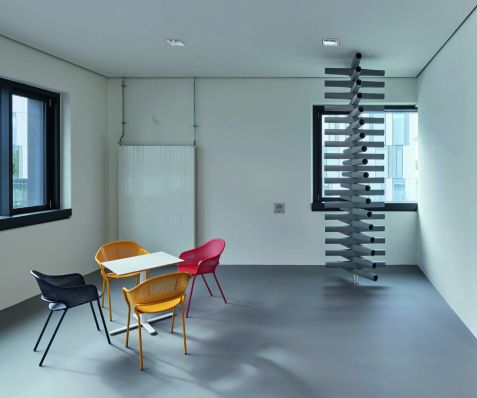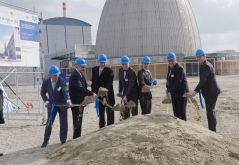MLZ is a cooperation between:
 > Technische Universität München
> Technische Universität München > Helmholtz-Zentrum Hereon
> Helmholtz-Zentrum Hereon
 > Forschungszentrum Jülich
> Forschungszentrum Jülich
MLZ is a member of:
 > LENS
> LENS > ERF-AISBL
> ERF-AISBL
MLZ on social media:

MLZ (eng)
Lichtenbergstr.1
85748 Garching
22.10.2020
Strengthening of neutron research in Garching

In view of the Corona pandemic, the opening ceremony took place purely virtually. © Juli Eberle / TUM
Every year, up to 1,200 guest scientists from all over the world come to perform measurements at the Heinz Maier-Leibnitz Research Neutron Source (FRM II). Technical University Munich (TUM) and Forschungszentrum Jülich are now expanding the research capacities of the world’s most versatile neutron source with two new buildings providing a total of 4,550 square meters of floor space for laboratories, offices and workshops.
Thanks to their unique properties, neutrons provide important insights for many scientific fields, from biology, chemistry and physics to geosciences, engineering or material science. In this way neutron research contributes directly to the solution of fundamental problems of our society. The FRM II belongs to the few high flux neutron sources for research purposes and radioisotope production in Europe.
Led by the Technical University Munich, Forschungszentrum Jülich and Helmholtz-Zentrum Geesthacht, neutron research institutions have joined forces under the organizational umbrella of the Heinz Maier-Leibnitz Zentrum (MLZ) to further expand research and education opportunities in Garching, so that Germany will continue to be one of the world’s leading nations in neutron research.

The artwork "More or less" by Olaf Probst in the office and workshop building at the Heinz Maier-Leibnitz Centre. © Valentin Wormbs
Currently over 400 people work at MLZ and FRM II. They use 27 scientific instruments, six more are under construction. Since the instruments can only be operated by competent scientists, the number of employees is also growing continuously. In addition, there are up to 1,200 guest scientists every year, over 50 percent come from abroad, who also require experimental and office space.
The two new buildings now meet the increased space requirements. The southern building was commissioned by the Federal Ministry of Education and Research (BMBF) for scientists from Forschungszentrum Jülich and Helmholtz-Zentrum Geesthacht. The northern building was commissioned by the Free State of Bavaria for the TUM. The total construction costs amount to around 38 million Euro. The project was managed by the State Building Authority Rosenheim.
Room for more cooperation
“With the construction of the two new buildings at the Heinz Maier-Leibnitz Zentrum in Garching, we have literally created space for more science – Space for more basic research and space for more application-oriented research in areas such as energy, health and the environment. Neutrons, with their unique ability to study the structure and function of materials and components, can make significant contributions to this. The Federal Ministry of Education and Research is particularly concerned with the transfer of research results from basic research into innovative applications. The MLZ succeeds in this in a convincing way”, says Thomas Rachel, MdB, Parliamentary State Secretary, Federal Ministry of Education and Research. “Based on this potential, the Federal Government is contributing over 20 million euros for the construction of the buildings and will continue to provide further funds in the millions by way of institutional funding.”
Bernd Sibler, Bavarian State Minister for Science and the Arts highlights: “Research with neutrons in Germany started here in Garching more than 60 years ago at the “Atomic Egg”. Very specific applications have emerged from science: Radioisotopes against cancer or semiconductors for power transport. It shows: This is where science has been working for people for decades, where scientists find answers to the pressing questions of our time. The joint federal and state investment therefore has an economic and social dimension in addition to the scientific one. Here we are investing in research for the future.”

Church blessing donated Katarina Freisleder (r.) of the evangelist university municipality and Dr. Thomas Schindler of the catholic university municipality to the TUM. © FRM II / TUM
“The Heinz Maier-Leibnitz Research Neutron Source is the most powerful neutron source in the world and as such a scientific beacon on the map of Bavaria, Germany and Europe,” says Prof. Thomas F. Hofmann, President of TUM. “Thanks to the unsurpassed performance spectrum of our neutron source, federal and state investments in the spatial infrastructure will bear abundant fruit.”
“Neutron research offers the unique opportunity to understand phenomena on the atomic scale and thus to gain fundamental knowledge from which the development of new technologies can benefit significantly,” says Prof. Wolfgang Marquardt, Chairman of the Board of Directors of Forschungszentrum Jülich. “The mission of the Jülich Centre for Neutron Science is to make the best instruments available at the best sources for this purpose, and we are further strengthening this mission with the expanded laboratory, workshop and office space at Germany’s most powerful neutron source.”
“The neutrons attract scientists from all over the world to Garching to solve the challenges of the future: They are researching new antibiotic agents, creating the basis for more efficient data storage of tomorrow and advancing the energy transition with battery and hydrogen research,” says Prof. Peter Müller-Buschbaum, spokesman of the MLZ-directorate and scientific director of the FRM II. “The new buildings give room for new ideas and cooperation, also beyond the borders of institutional affiliations.”
In conjunction with the grand opening celebration, Doris Lackerbauer, the head of the State Building Authority Rosenheim, which was responsible for the execution of the construction, handed over the symbolic key to the two directors of the MLZ, Prof. Peter MuellerMüller-Buschbaum and Prof. Stephan Förster. Taking into account the dangers of the corona pandemic, the celebration was conducted virtually, featuring a video broadcast for the invited guests and the cooperative partners all over Germany.
The two four-story buildings on opposing sides, which frame a view of the “Atomic Egg,” which is a protected national monument dating back to 1957, were designed by the architectural firm HENN. The work of art, “Mehr oder Weniger“ [“More or Less”] by the Munich artist Olaf Probst correspondingly pervades both buildings.
Contact
Prof. Dr. Peter Müller-Buschbaum
Technical University of Munich
Research-Neutronsource Heinz Maier-Leibnitz (FRM II) and
Heinz Maier-Leibnitz Zentrum (MLZ)
Lichtenbergstr. 1, 85748 Garching, Germany
Tel.: +49 89 289 14966
E-Mail: peter.mueller-buschbaum@frm2.tum.de
Web: www.frm2.tum.de / www.mlz-garching.de
The new buildings at MLZ
The two new buildings are providing a total of 4,550 square meters of floor space for laboratories, offices and workshops.
Related News
MLZ is a cooperation between:
 > Technische Universität München
> Technische Universität München > Helmholtz-Zentrum Hereon
> Helmholtz-Zentrum Hereon
 > Forschungszentrum Jülich
> Forschungszentrum Jülich
MLZ is a member of:
 > LENS
> LENS > ERF-AISBL
> ERF-AISBL
MLZ on social media:



